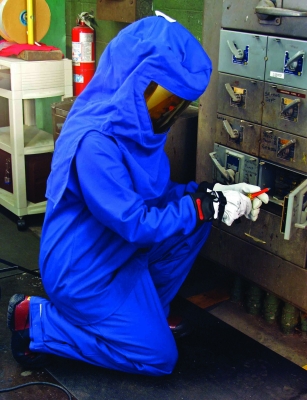LTL Blog
Lineman's Testing Laboratories of Canada
Ensuring Electrical Sa...
Ensuring the Integrity...
Tips for safety when w...
7 Benefits to Using Gr...

An arc flash can cause damage to equipment and result in job downtime, but more importantly it can cause burns, blindness, nerve damage and even death. The majority of hospital admissions following electrical accidents are due to arc flash burns (per NFPA 70E-2004).
That’s why at Lineman’s Testing Laboratories (LTL), we stress the importance of regular equipment maintenance, training and the use of proper PPE for anyone who works on or near live electrical apparatus - we’ve created these 5 tips to help you stay safe while on the job.
1. Identify the hazards through arc-flash hazard studies
Performed by qualified engineers and technicians, Lineman's Testing Laboratories offers CSA Z462-compliant arc flash hazard analyses which determine the potential arc flash incident energies and boundaries, shock hazard boundaries and proper personal protective equipment required for activity within the arc flash boundary. The CSA Z462 states that this analysis should be updated when a major modification or renovation takes place and should be reviewed periodically, at least every five years, to account for changes in the electrical distribution system that could affect the results of the analysis.
2. Affix proper warning labels to all plant equipment
LTL ensures warning labels identifying potential hazards and required safety equipment are affixed to all applicable electrical equipment. The Canadian Electrical Code (CEC) mandates that electrical equipment shall be field-marked to warn persons of potential electrical shock and arc flash hazards.
3. Select the proper personal protective equipment (PPE)
The Occupational Health & Safety Act of Ontario states that it is the responsibility of the employer to take every precaution reasonable in the circumstance for the protection of the worker: "The worker shall use rubber gloves, mats, shields and other protective equipment and procedures adequate to ensure protection from electrical shock and burns while performing the work."
Determine the calorie rating for your PPE. A calorie is the energy required to raise one gram of water one degree Celsius at one atmosphere. Approximately one calorie is the heat energy your finger receives if you hold it in a cigarette lighter flame for one second. Applied for one second, 1.2 calorie per centimeter squared can cause a second-degree burn. Once the calorie rating is determined for the amount of energy that could be delivered to a point at a distance from an arc flash, the ATPV rating is calculated and proper PPE can then be selected.
To provide maximum worker safety and protection from burns or electrocution, consult Lineman's Testing Laboratories product specialists to ensure the proper PPE selection process is followed and to provide proper training and ongoing support required for compliance.
4. Provide training for proper care and use of PPE
It is imperative that workers understand how and why the required PPE will help them as well as how to properly care for and inspect this equipment to comply with legislation. Insulating rubber gloves, arc flash clothing, face protection, temporary grounding equipment and phasing devices have specific application ratings. Insulating rubber gloves, grounds sets, live line tools and metering/phasing equipment have recertification requirements.
Insulating rubber gloves are to be worn by those working on or near live exposed parts of installations, equipment or conductors. Rubber gloves are the basic protection from electrical shock. Leather protectors must be worn over insulating rubber gloves to provide mechanical protection against cuts, abrasions and punctures as well as protect the rubber gloves from possible physical damage in use. They are specifically designed and are to be used solely for the purpose of protecting the rubber gloves (and must comply with ASTM F696).
To maintain the highest level of insulating protection and ensure long life, it is essential that the rubber gloves are properly cared for, stored, inspected and electrically tested on a regular basis. Recertification of insulating rubber gloves, as per ASTM F496, requires that re-test intervals should not exceed six months.
Lineman's Testing Laboratories is the largest stocking Salisbury by Honeywell distributor in Canada of insulating rubber gloves and related personal protective equipment. As well, LTL is home to Canada's largest NAIL-accredited high voltage testing facilities, conveniently located in Toronto and Edmonton.
5. Minimize plant equipment failure through regular maintenance
Early detection of electrical equipment weakness or potential hazard through regular maintenance of high and low voltage electrical and mechanical components and analysis of electrical insulating fluids, helps to reduce production downtime and associated costs, but most importantly, improves safety conditions for system operating personnel. Performed and directed by skilled technicians, Lineman's Testing Laboratories of Canada offers comprehensive maintenance programs tailored to your specific needs. These extensive programs include testing and calibration, inspection, adjustment, cleaning and repair as required of high and low voltage electrical and mechanical components, and analysis of electrical insulating fluids. After service, a detailed data report including summary and recommendations to maintain a reliable service is prepared and delivered.
SUMMARY - Ensure the following CSA Z462 requirements are met:
- A safety program is in place clearly defining responsibilities
- An Arc Flash Hazard Analysis is conducted and reviewed periodically
- Warning labels are affixed to all applicable electrical equipment
- On-going worker training is provided for the care and use of personal protective equipment
- An electrical work policy is in place for how, where, when, and who
- All workers are equipped with the proper tools to ensure safe work practices
- A personal protective equipment re-recertification schedule is in place and strictly adhered to
For classroom or online training, please visit our Training & Education page.
Your comment will go through an approval process and may not be visible to the public right away.


